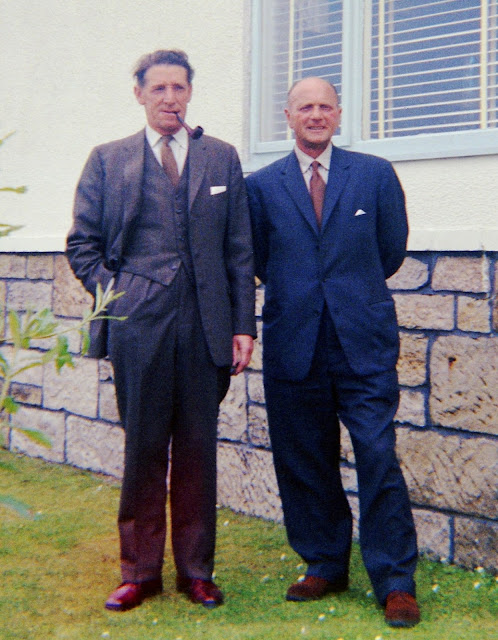Albert
Edward Ivall (known as Ted) was a great grandson of David Ivall (1795-1850), a
successful coach maker who was a brother and business partner of my ancestor
Thomas Ivall (1781-1835). David left £5,000 (a substantial sum of money then)
to each of his six children when he died. The youngest was Albert Ivall
(1839-97), who apparently lost most of his inheritance between 1861 and 1871,
when he was a farmer. He was declared bankrupt in 1875 following a court case
brought against him by the Mayor and Corporation of Hastings. His eldest son
was Albert Ivall junior (1862-1905), the father of Albert Edward Ivall.
In
1891, Albert Ivall junior married Clara Amelia Stock in Poplar, East London.
They had six children, namely Mabel Edith (1892-1963), Ethel Clara (1893-1959),
Albert Clifford and David William (twins born in 1896 who both died in 1897),
Harold Victor (1900-85) and Albert Edward, who was born on August 4th
1902 in Poplar. Albert’s father ran a grocer’s shop at 10 White Post Lane,
Poplar. The site of this building (which no longer exists) was near Hackney
Wick tube station, just to the west of the Olympic Park. Albert was baptised on
August 24th 1902 at St Mark’s Church, Victoria Park.
Albert’s
father died in 1905 aged 43 of “phthisis”, another name for tuberculosis. His
will left his entire estate (£608 net) to his wife, Clara. She managed to get
Harold and Albert into a school for orphans at Wanstead, on the edge of Epping
Forest. Entry was by election only. These were normally held in a tavern in
Fleet Street or Ludgate Hill and at The London Tavern in Bishopsgate Street.
Albert got 1,209 votes in the election held in May 1908. The 1911 census shows
Albert (aged 8) and his brother Harold (10) at the school. It was renamed Royal
Wanstead School in 1939 and closed in 1971. The school building is now
Snaresbrook Crown Court.
Albert’s
mother (Clara) moved to Sussex. Trade Directories for 1909, 1911 and 1913 list
her under the heading “Apartments” and give her address as 29 Gensing Road, St
Leonards, Hastings. In 1916 and 1920 she is listed as a dress maker at 100
Burford Road, Nottingham. Electoral registers for 1922 to 1924 show Clara and
her son Harold living at 56 Noel Street, Nottingham. Albert would have been too
young to be listed on the 1922 electoral register.
Albert in 1919
(aged 16)
Albert
decided to emigrate to Australia. Shipping records show that he travelled third
class on board the SS Orsova (an ocean liner owned by the Orient Shipping
Line), leaving London on April 1st 1922 and arriving at Freemantle
on May 4th 1922. He was listed as aged 19, an engineering
apprentice, home address 56 Noel Street, Nottingham. In 1925 electoral
registers show that Albert was a farm hand living at Yorkrakine, Toodyay,
Western Australia. Toodyay, is a small town on the Avon River in the wheatbelt
region of Western Australia, 85 kilometres north-east of Perth. He later
returned to England, arriving at Tilbury on March 17th 1930, having
travelled 3rd class on the SS Orsova from Freemantle. He was then
aged 27, an engineer with 56 Noel Street, Nottingham as his proposed address.
On
September 21st 1935, Albert married Evelyn Gertrude Parsons at Holy
Trinity Church, Nottingham. He was aged 33, an excavator driver living at 56
Noel St. She was aged 30, living at 37 Forest Row, a daughter of George Alfred
Parsons, a retired outfitter. They went on to bring up two children, a girl and
a boy.
The
1939 register shows Albert and Evelyn living at 15 Wolverton Road, Birmingham
and gives his occupation as “aero detail fitter”. Electoral registers for 1945,
1950 and 1955 also show Albert and Evelyn living at 15 Wolverton Road, Northfield,
Birmingham. This is quite near Austin Motors at Longbridge, where Albert worked
for many years.
One
of Albert’s nieces recalls that he had a cheerful personality and would
exchange banter with his brother Harold when they met.
Albert in 1955
Margaret
Rose Ivall, Albert and Evelyn’s daughter, married in 1960. Sadly she died
suddenly of heart failure in 1974 aged only 35.
Albert
retired in 1967 and continued to live at 15 Wolverton Road until he died on 27th
May 1987 aged 84 at West Heath Hospital, Birmingham. He was cremated at Lodge
Hill Cemetery in Selly Oak, Birmingham and his ashes were scattered in the
Garden of Remembrance there. His wife Evelyn died in 1995 aged 91.












